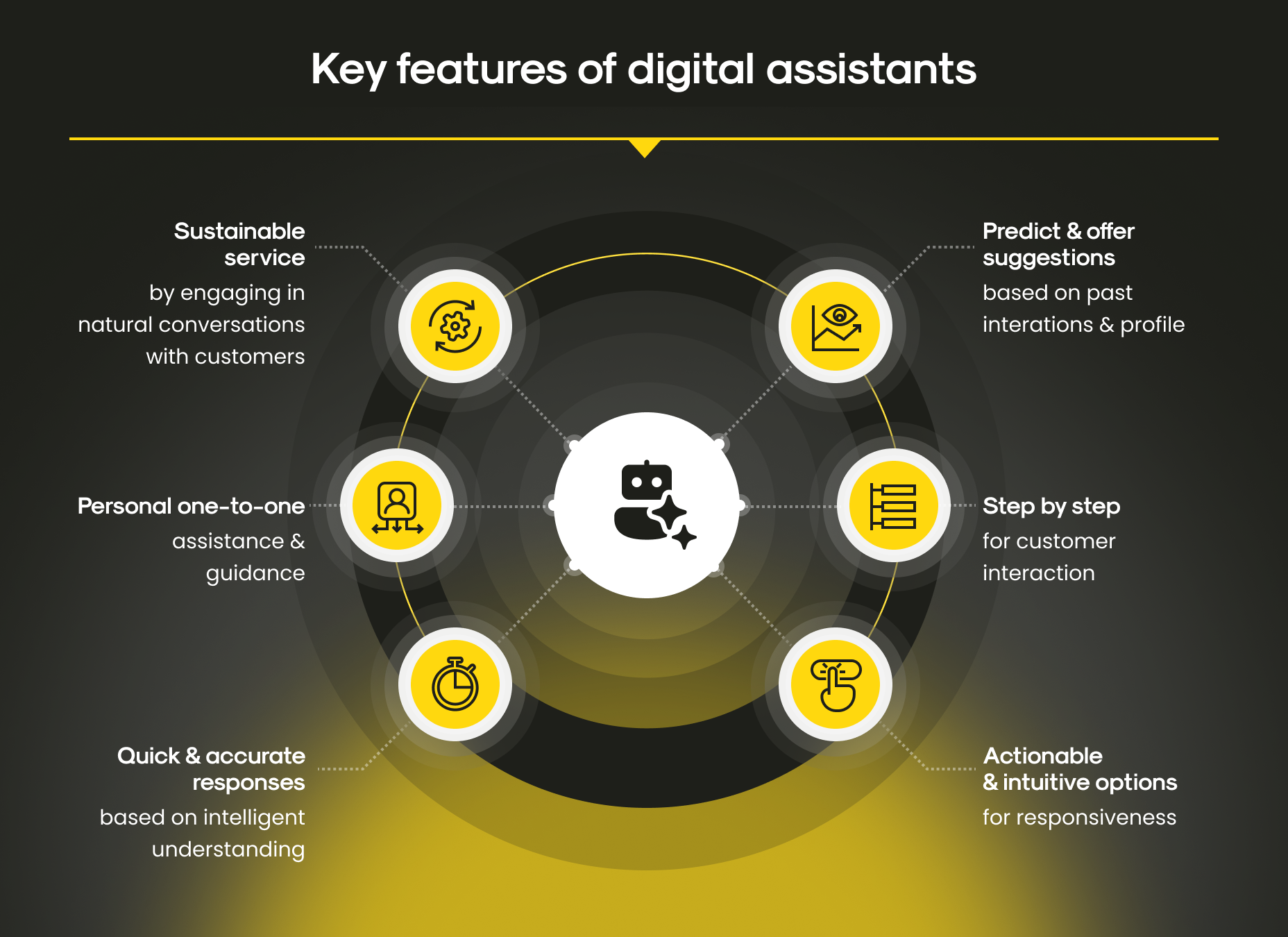Imagine an assistant that works around the clock, understands your preferences, and handles tasks with precision. That’s the role chatbots take on when they function as digital assistants, driven by AI to provide meaningful interactions and reliable support.
They matter because the demands of business and daily operations continue to accelerate. Organizations manage an increasing number of processes, data streams, and customer touchpoints simultaneously. Chatbots address this complexity by reducing workload, delivering quick answers, and ensuring continuity, allowing teams to focus on higher-value strategic activities. In this article, you’ll learn:
- What sets digital assistants apart from chatbots, and why the distinction matters for businesses
- Why chatbots-as-assistants are thriving right now, with AI maturity and customer expectations driving adoption
- The most impactful use cases in retail and e-commerce: from personalized product discovery to post-purchase support
- How real-world brands like H&M use chatbots to blend fashion advice, product availability, and transaction support in one flow
- Why timing is critical: the role of advanced NLP, cheaper infrastructure, and seamless integrations
- The challenges businesses face when deploying chatbots, and how to avoid common pitfalls like poor context handling or over-automation
Digital assistants vs. chatbots: the difference
First things first, let’s look at the difference. At first glance, chatbots and digital assistants look like close cousins, as both lean on natural language processing to chat with users. But under the hood, their ambitions and capabilities are quite different.
Digital assistants are the multitaskers. They’re built to manage a wide spectrum of activities across apps, devices, and services. From controlling your smart home to scheduling meetings or pulling up directions, they thrive on variety and flexibility.
Chatbots, by contrast, are specialists. They usually tackle a single type of request, say, booking a hotel, tracking a package, or helping you find a product. Their strength lies in focus, not breadth.
Conversation depth also separates the two. Digital assistants can carry on ongoing, context-rich dialogues, remembering what you said five minutes (or five days) ago. Many chatbots, however, reset with every interaction, treating each message as if it’s your very first.
Integration is another dividing line. Assistants typically connect with a wide network of third-party tools, platforms, and even physical devices. Chatbots usually live inside websites, apps, or messaging platforms and are often tied to a single system or database.
Of course, the boundaries aren’t fixed. Some chatbots are becoming smarter and more context-aware, while digital assistants sometimes act like simple, single-purpose bots. The two worlds are blending, but the distinction remains: assistants aim for breadth, while chatbots focus on depth within a specific task.
Why chatbots-as-assistants are having their moment
Businesses are under pressure to move faster, serve smarter, and keep customers happy around the clock. That’s where chatbots-as-assistants step in, evolving from simple FAQ bots into genuinely capable helpers that understand, adapt, and deliver.
1. Always-on support that doesn’t sleep
Human agents get sleepy, but bots don’t. They’re deployed across websites, messaging apps, and voice systems, ready to answer questions, reroute support, or recommend products. They’re always “open,” and that is pure gold for customer satisfaction.
2. Context matters, and they’ve got it
These aren’t one-question wonders. Many of today’s assistants understand context, remember past chats, and can pull answers from smart knowledge bases. They learn, adapt, and feel surprisingly human without the emotional baggage. AI fitted with NLP and generative capabilities delivers that kind of conversational intelligence.
3. Efficiency with a wink
By automating routine tasks (like checking your delivery, booking an appointment, or giving you quick product answers) bots free up human agents to focus on the complex, empathetic stuff. Think of it as your friendly support intern, but powered by AI and with impeccable punctuality.

Key features of digital assistants
Key takeaway
Put simply, the rise of chatbot assistants is a function of necessity. They combine availability, memory, and efficiency in ways humans simply can’t scale. The result is just pure joy: happier customers, lighter workloads, and teams free to tackle the work that really requires a human touch.
Types of assistants
Real-world case studies that aren’t just hype. Here are some strong use cases in retail/ecommerce: they show how chatbots move from gimmicks to real value, and why shoppers are starting to prefer them over clunky search bars. Think of them as pocket-sized shopping concierges that turn browsing into buying.
- Personalized product discovery. Instead of endless scrolling, shoppers can tell the bot what they want (“show me a red cocktail dress under $100”), and it curates results instantly.
- Style and size guidance. Digital assistants help reduce returns by suggesting sizes based on past purchases or even body measurements. They also offer styling advice, like pairing shoes with an outfit.
- Gift finders. Shoppers can describe the recipient (“tech-loving dad who hates clutter”), and the bot suggests spot-on gift options.
- Real-time availability and pricing. Customers can ask “Is this in stock near me?” or “What’s the best deal right now?” without digging through multiple pages.
- Post-purchase support baked into the assistant. Beyond the sale, the same bot helps with order tracking, return labels, or warranty questions, so the assistant feels like a full-cycle concierge.
In short, these chatbots act less like clunky FAQ machines and more like always-on digital shop assistants, the kind you wish you had in a real store but without the awkward “just browsing, thanks” moment.
H&M: how it works in real life
The fashion giant has woven AI-driven chatbots into its retail strategy, using them to create smoother customer journeys and to tame the chaos of fast fashion inventory. By focusing on both personalization and operational agility, H&M turned its chatbot assistant into more than a help desk: it became a stylist, stock manager, and shopping buddy rolled into one.
H&M Kik chatbot. The company launched a chatbot on Kik Messenger that let shoppers browse clothing, answer style questions, and receive curated outfit suggestions directly in chat. By engaging customers in their natural digital habitats, H&M boosted brand stickiness among younger audiences and shortened the path from browsing to purchase.
Style quizzes and outfit builders. H&M’s chatbot asks customers a few quick questions about their preferences, then generates outfit ideas that align with their personal taste. This interactive layer mimics the experience of having a personal stylist, nudging customers toward faster, more confident purchase decisions.
In regard to all these insights, H&M’s approach shows how chatbots can blend fashion advice, instant product discovery, and transaction support into one ongoing conversation, turning what used to be a fragmented shopping journey into a single, engaging flow.
Key performance indicators:
Kik chatbot is available on the Kik messenger app, with over 15 million monthly active users. Its key benefits include:
- Stronger customer interaction
- More enjoyable shopping journey
- Noticeable lift in sales conversions
The Kik chatbot kept shoppers engaged, reaching an impressive 86% interaction rate, with users spending about four minutes per session. Even better, its 8% click-through rate outperformed H&M’s own email campaigns, which averaged just 2%.
Why timing matters now
We’ve had chatbots for over a decade, so why are they suddenly working well today? Two words: AI maturity. Natural Language Processing (NLP) has advanced to the point where bots understand nuance, intent, and even humor (though not always good humor). Add to this cheaper cloud infrastructure and better integration options, and businesses now get assistants that are not just cost-cutters, but actual value-creators. In short: yesterday’s clunky scripts are today’s intelligent allies.
Building trust through transparency
Customers won’t engage with a bot they don’t trust. This means privacy-first design, clear disclosure when a bot is involved, and giving users the option to escalate to a human. Companies that get this balance right see higher adoption rates and better customer satisfaction. In fact, chatbots don’t have to replace humans: they just need to complement them while being honest about their role.
From assistants to agents
The evolution doesn’t stop at assistants. The rise of agentic AI means bots won’t just respond, they’ll act proactively: restocking inventory when levels drop, scheduling follow-ups with leads before you even ask, or flagging unusual transactions before they become disasters. The shift from passive to proactive will redefine how we think about “digital help.”
Key takeaway
Chatbots have finally hit their stride: not because they’re new, but because the technology, trust, and expectations around them have matured. With smarter NLP, transparent design, and a move toward proactive agentic AI, they’re evolving from cost-saving add-ons into trusted digital partners that drive real business value.
Challenges along the way
For all their progress, chatbot assistants aren’t magical silver bullets. They come with their own set of hurdles that businesses need to navigate before the “digital helper” dream turns into a support ticket nightmare.
1. Getting the context wrong
Even the sharpest NLP model occasionally misunderstands tone, slang, or intent. A bot that confidently gives the wrong answer is worse than no answer at all. Without proper training and oversight, context gaps can leave customers frustrated instead of delighted.
2. Data privacy and trust
Users are rightly cautious about who sees their data. If a chatbot asks for sensitive details without transparency, alarms go off. Compliance with HIPAA, GDPR, and other frameworks isn’t optional: it’s the bedrock of sustainable adoption.
3. Integration headaches
A bot is only as smart as the systems it connects to. Poor integration with CRMs, ERPs, or inventory systems means customers get stuck in the “let me transfer you to a human” loop. That’s not efficiency; that’s digital déjà vu.
4. Over-automation risks
Automating everything sounds great, until a customer with a complex issue is forced to battle through a wall of menus. Striking the right balance between human and bot interaction is critical, or you risk alienating the very people you’re trying to serve.
5. Keeping the bot sharp
AI assistants need constant learning. Left unattended, they can become outdated, inaccurate, or just plain annoying. Ongoing updates, retraining, and performance monitoring are part of the package if you want long-term value.
Key takeaway
Chatbots are powerful, but they’re not “set it and forget it” tools. Success comes from thoughtful design, trust-first implementation, and continuous optimization. Get those right, and the challenges turn into stepping stones toward stronger, smarter customer engagement.
How Mitrix can help
Mitrix specializes in building AI-powered personalization systems that combine advanced recommendation models with human-like conversational experiences. From integrating AR try-on capabilities to designing privacy-first consent flows, Mitrix ensures that every interaction is meaningful, measurable, and on-brand. Our platform supports identity resolution across channels, real-time data processing, and attribution tracking, enabling retailers to both prove and improve their personalization ROI.
At Mitrix, we build AI agents designed around your needs, whether you’re looking to boost customer support, unlock insights from data, or streamline operations. Let’s create a robust AI agent tailored to transform your business!
Customer support agent
Delivers 24/7 customer assistance, resolves inquiries efficiently, addresses issues, and enhances overall customer satisfaction.
Healthcare assistant
Performs preliminary symptom assessments, organizes patient records, and provides accurate medical information.
Financial advisor
Delivers tailored investment advice, monitors market trends, and creates personalized financial plans.
Sales agent
Identifies and qualifies leads, streamlines sales processes, and drives growth by strengthening the sales pipeline.
Data analysis agent
Processes and interprets large datasets, delivers actionable real-time insights, and aids in strategic decision-making.
Virtual assistant
Organizes schedules, manages tasks, and provides timely reminders to enhance productivity.
Whether you’re coordinating international freight, managing warehouse logistics, or optimizing last-mile delivery, Mitrix can help build the chatbot system to match. Contact us today to discuss your virtual assistant!
Summing up
Nowadays, chatbots as digital assistants have become real, capable, and highly effective. They manage multiple tasks, understand context, and engage in natural interactions. From retail to healthcare and beyond, they handle routine processes and streamline operations, allowing people to focus on work that requires creativity, strategy, and empathy.
The next step is agentic AI, where assistants no longer wait for instructions but take proactive action. Built thoughtfully, these systems can significantly enhance both our digital experiences and the way we live and work.


